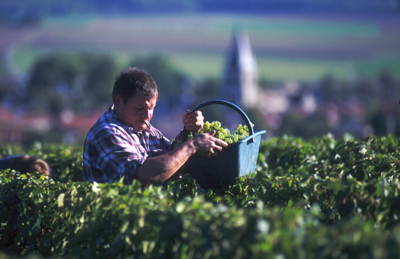



Notes From The Harvest
We just finished the harvest last Thursday, the 5th October. We pressed the last grapes from Mailly Grand Crû in the evening. Because our wines are made from late-picked grapes, we started the 25th September. First, with the Pinot Meunier in the Marne Valley. Very ripe, particurlarly on the SO4 stock(the SO4 and 3309 stocks are early maturing and the 41B - late).
What was the best? - Pinot Meunier: nice degree: 10°5 - 11° and + vol. alcohol. And then Pinot Noir and then Chardonnay. Total acidity: from 7,5 to 8 g/l. H2SO4. Good balance: acidity / natural degree. First, three sunny days: 25-26-27 September. Cloudy and rainy days: 28-29 September, sunny days: 30 September - 1st October. Then 2nd October: rain! We stopped the harvest during two days, and re-started the 5th October, to finish the Grand Crû with a cloudy weather in the morning, and sun in the afternoon.

We picked the Pinot Meunier and Pinot Noir grapes for the Rosé "de saignée" (we make it the hard way, by maceration) and the "Coteaux Champenois" red wine during the sunny days. We gathered the Grand Crû from the village of Mailly at the end, because we had a violent hailstorm in the beginning of July on this vineyard, so there were not enough leaves, and the ripeness was late. But, by the 5th October, it was nice because the rare Chardonnay from Mailly was 10°3 Alcohol and the Pinot Noir 10°5 Alcohol.
The set price for the grapes this year is FF26.25 per kilo. That is the price for grapes from Grand Crû vineyards which are rated at 100%. Other vineyards are rated lower to as little as 80%, and so their grapes only fetch 80% of the Grand Crû price. The 3 grape varieties (Chardonnay, Pinot Noir or Meunier) cost the same price. However, the must (grape juice) from the cuvée (first pressing), 1ere Taille and 2eme Taille (the second and third pressings) have different prices. It is cheapest to buy a hectolitre of "2eme Taille" (the third pressing)...this is where the very cheapest Champagnes come from.
The rating system is very old, and rates whole villages. There are only 17 Grands Crûs villages in the whole of the Champagne region. But the Crû is delimited by the area of the village, not by the soil, the subsoil, the rock, the micro-climate, the slope, the top or the lower hillside of the fields themselves. The best grapes often come from a vineyard where the vine has had to work hard to survive, on a slope, on rough soil. If the outskirts of the village area is on a plain ... the grapes from those flat vineyards are rated Grand Crû, the same as a grape from the middle of the hillsides...even if the slope, the soils, the subsoil, the micro-climate are absolutly different. Surely ... this is not the same quality grape and wine ... of course! I prefer a grape from a terrace in steep slope in a middle of the hillsides in a "small" cru than a grape from a flat plain in a Grand Crû area.
Since 1985, we have our own vineyards in Grand Crû Mailly-Champagne = 1 ha 66 a 17 ca (areas : les Barraquines, les Godats, les Coutures, Les Fayes, les Chalois, les Crayats, Sous La Ville, Les Voies de Ludes, Les Poules). Of course, our own Grand Crû grapes are picked, pressed and fermented and bottled at our own winery (vendangeoir). Home-made, in our own oak barrels and vats, by my own hands. Since 1985, Every year, we also buy 5000 kgs. of grapes from a grape-grower friend in Mailly Grand Crû. Picked up the grapes at his vineyard, and pressed them at our own winery with our own press.
At the moment the musts are fermenting, all is OK. The first 2000 Pinot Meunier wines had finished their fermentation since two days. We could taste and try the new 2000 wines in few days and weeks, in order to know if this year it will be good, very good, the best ... the vintage of the century ! ;-)
Best sparkling wishes!
Francis Boulard
Chêf du Cave
Champagne Raymond Boulard